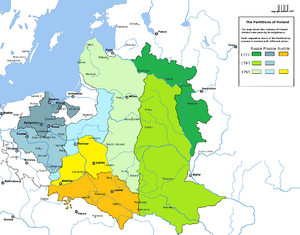Third Partition of the Polish-Lithuanian Commonwealth
The Third Partition of Poland (1795) was the last in a series of the Partitions of Poland and the land of the Polish–Lithuanian Commonwealth among Prussia, the Austrian Empire, and the Russian Empire which effectively ended Polish–Lithuanian national sovereignty until 1918. Accordingly, the partitioning powers agreed to permanently erase Poland's name from existence in any historical context, including from their respective encyclopedias, in an attempt to curb Polish dissidence and nationalistic fervor. When such sources or legal texts needed to refer to Poland or the Polish people, names of Poland's various historical regions, such as Masovia, were used instead. This prevarication ultimately resulted in numerous Polish uprisings during the period. The third partition, and the partitions of Poland in general, remains a controversial topic in modern Poland, in academic circles and public discourse alike; especially in context of Poland's relations with Russia, which profited the most from the partitions, by acquiring most territory and wealth, thereby becoming one of Europe's foremost powers at the time.
Following the First Partition of Poland in 1772, in an attempt to strengthen the greatly weakened Commonwealth, King Stanislaus Augustus put into effect a series of reforms to strengthen Poland's military, political system, economy, and society. These reforms reached their climax with the enactment of the May Constitution in 1791, which established a constitutional monarchy with separation into three branches of government, strengthened the bourgeoisie and abolished many of the privileges of the nobility as well as many of the old laws of serfdom. In addition, to strengthen Poland's international standings, King Stanislaus signed the Polish-Prussian Pact of 1790, ceding further territories to Prussia in exchange for a military alliance. Angered by what was seen as dangerous, Jacobin-style reforms, Russia invaded Poland in 1792, beginning the War in Defense of the Constitution. Abandoned by her Prussian allies and betrayed by Polish nobles who desired to restore the privileges they had lost under the May Constitution, Poland was forced to sign the Second Partition of Poland in 1793, which ceded Dobrzyn, Kujavia, and a large portion of Greater Poland to Prussia and all of Poland’s eastern provinces from Moldavia to Livonia to Russia, reducing Poland to one third of her original size prior to the First Partition.
...
Wikipedia

